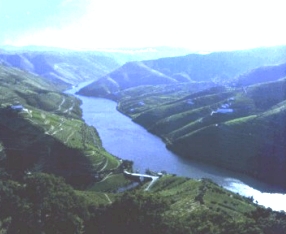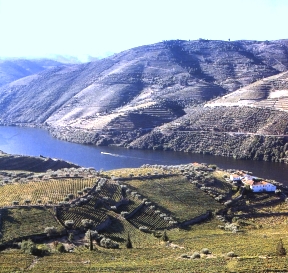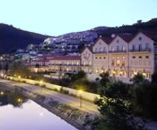|
|
|
|
PORTUGAL - THE DOURO VALLEY
The River Douro rises in Spain and flows more or less East / West across Northern Portugal reaching the sea at Portugal's second city, Oporto. Once a fast flowing river of rapids and narrow ravines it has been tamed over the past 25 years by the construction of 8 dams along its length giving it, in most places, a tranquil, lake-like appearance.

The valley is spectacularly beautiful with the hills falling steeply down to the water´s edge becoming more and more sparsely populated and wild the further inland one travels, with more of the land being given over to terraces of vines and, to a lesser extent, olive groves. This is port country and was, in fact, the world´s first demarcated wine region being established in 1756. Evidence of the port industry can be seen along the valley with all the famous company names - Cockburns, Taylors, Sandeman and others - appearing on large placards on the hillsides. The colour of the land changes throughout the year as the vines mature. February and March though also see the almond trees in blossom, particularly in the upper reaches, creating blankets of pink-white everywhere which, with fine weather, brings the Portuguese out for the first picnic of the year.Generally, though, there is little in the way of developed tourism, visitors are comparatively few and, as far as crowds are concerned, getting around is fairly easy. However, the roads zigzagging up and down the mountainsides and between the tributary valleys can be difficult driving but it does offer fantastic unspoilt scenery. More relaxing modes of transport are available, however. Cruise boats ply up and down the valley negotiating the dams via locks of sometimes breathtaking height. Trips run from Porto, Regua and Pinhao. Alternatively, the Douro railway line which runs 175 kilometres from Oporto to Pocinho joins the river at Mosteiro and for the next 100 kilometres does not leave the bank, making this one of Europe´s great rail journeys.
Apart from the port, the excellent Douro wines, both white and red, make excellent accompaniments to the food of the region. Whilst fresh fish is readily available (just as it is everywhere in Portugal) here the meats of the interior start to come into their own with excellent smoked hams and some spicy sausages. If lucky you might see wild boar (javali) on some of the menus.

REGUA
This is the 'capital' of the Douro Valley, a town (actually a city) that grew up because of the development of the port industry being a collecting point for the wines before being transported down river to Vila Nova de Gaia, the other side of the river from Porto. For many years this was done in a traditional boat called a rabelo, examples of which can be seen in Regua. Later, with the opening of the railway in 1887, by train but now somewhat unromantically, by road.Regua is also the headquarters of the Port Wine Institute, which oversees all matters relating to the production of port. The huge Sandemans logo dominates the hill opposite the town just to remind you of the reason for its existence. The tourist office in Regua will be able to provide details of those wine estates offering tours and tasting as well as details of boat trips. The town straddles the river with the station at the eastern end. The centre with its narrow streets and interesting selection of small shops is at the western end. Between the two the river front especially, but also the streets immediately behind, contain a lively selection of cafes, bars and restaurants which really come alive at night.
Dining in Regua
Plenty of options but on the river front try the following :
O Gato Preto - basic Portuguese grill cuisine but good value and friendly service.
O Malheiro - not actually on the river front but with a signposted entrance up the steps from it to the vine covered courtyard. Good regional cuisine, especially pork dishes such as rojoes, a marinated, fried pork dish.
Hotel Regua Douro - a new development on the riverbank almost opposite the station. The smart third floor restaurant has superb views over the river with a menu offering dishes from different parts of the country. Not too expensive either. Good value Sunday buffet lunch too.
Regua offers the best opportunities for day-to-day shopping with a large Continente supermarket on the edge of town but well signposted.
VILA REAL
A visit to the area should certainly include a trip on the railway to Vila Real. An incredibly engineered route which winds its way 25 kilometres along the Corgo Valley with some unbelievable horse shoe bends and everywhere, clinging to the hillsides, the grape vines which would, in places, appear impossible to harvest.Although an interesting and important regional centre, the main attraction at Vila Real is the Mateus Palace, the picture of which adorns the label of every bottle of Mateus Rose. The palace and its magnificent gardens are open to the public and are about four kilometres from the town, well signposted or, there is a fairly frequent bus service. In the town centre itself there are plenty of cafes offering a good value dish of the day. Two options worth considering would be :
O Churrasco on Rua Antonio Azevedo is an inexpensive grill house with a good atmosphere.
O Espadeiro on Avenida Almeida Lucano is a more expensive option but offers a varied menu with more local specialities.

PINHAO
The small town of Pinhao really marks the start of port production. Delightfully situated on the north bank of the River Douro, 25 kilometres east of Regua, it can be reached by road along the south bank or by rail along the north bank of the river. There are a number of small cafes and simple restaurants in the town alternatively, there is a pleasant picnic site on the river side.Exploring the upper reaches of the Douro beyond Pinhao becomes more complicated by road as a glance at the map will reveal, but the railway continues along the bank of the river as far as the village of Pocinho. Very few settlements exist along the line other than Tua, which is little more than a junction for yet another spectacular railway line, this time along the wild and rugged Tua Valley to Mirandela, a journey of around one and a half hours each way. Opposite the station is the surprisingly lively and good Cafe Estacao where an excellent lunch is served and locally produced wine available, ask for the 'Vinho Caseiro'. Down below the restaurant is a pontoon and landing stage, which makes another good picnic spot.
VILA NOVA FOZ COA
Reaching Vila Nova from Regua by road is a complicated but rewarding journey with some spectacular views as the roads wind erratiacally up and down the mountainside between the different valleys. The town is beautifully situated high above the River Coa, one of the tributaries of the Douro. This is very much an area of olives and almonds as opposed to grapes and the almonds, in particular, make a beautiful sight in early Spring. Vila Nova is also the closest town to the 22,000-year-old rock paintings, which were discovered during the construction of a new dam. Following considerable protest construction was halted and the whole area designated a world heritage site. Visiting is still difficult as the sites are remote but the local National Park Office is able to provide complete information. For the best food in Vila Nova try Restaurante Marisqueira in Rua Juiz Montinho, centrally located near the main square, which has some good regional specialities and good local wines. Try to find 'Arte de Coa' wine.LAMEGO
A short distance by road from Regua to the south this beautiful town developed as an agricultural trading centre at the meeting point of two ancient thoroughfares. Agriculture still continues to be important as can be seen from the rich green landscape. The town is certainly attractive but its most striking monument is the church and shrine of Nossa Senhora da Agonia which sits high up on the hillside above the wide central avenue in the town and approached via 700 or so steps zigzagging up the hill. The basically renaissance style Cathedral right in the centre of town, as well as the Castle, also warrant a visit. Restaurants, cafes and bars are plentiful in this lively town. Try :Churrasqueira Londrina in Rua Fafel. This somewhat basic eatery is popular with locals and has good grill food and very good prices.
Restaurante Novo in the main square near the Cathedral is an excellent place to sit outside. Limited menu but good prices.
Imperio is more expensive but has a more extensive menu than the norm, with some different regional specialities.
Lamego is well known throughout Portugal for its smoked hams (presunto) often served as an aperitif so don´t miss the opportunity to try them.
You may read on the account of a cruise across the Douro river.
Regua - Along the river front about 1 km from the station
Lamego - Centrally located just off the main square.
Vila Nova Foz Coa - Av. Gago Coutinho. This is the Coa Valley Archaeological Park Office not a Tourist Office. They will provide information on visiting the rock art of the Coa Valley.
There is, to be honest, little opportunity for organised sport in the area though plenty of good walking.
The nearest golf course is at Amarante
The nearest first division football is at Porto (3 Clubs) or Guimaraes though lower league football can be seen at most towns in the area. The season runs from mid August to June.
Festivals take place throughout the summer in virtually every town and village with live music, processions and a great atmosphere. Probably the most spectacular is at Lamego on and around the first weekend of September. Festivals are well publicised - look out for the colourful posters which appear in most cafes and shops.
Accommodation in the area